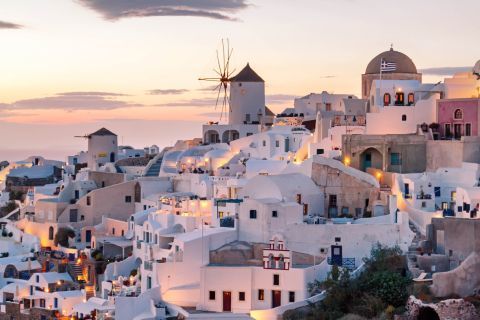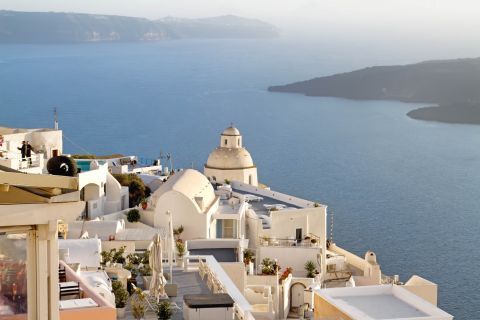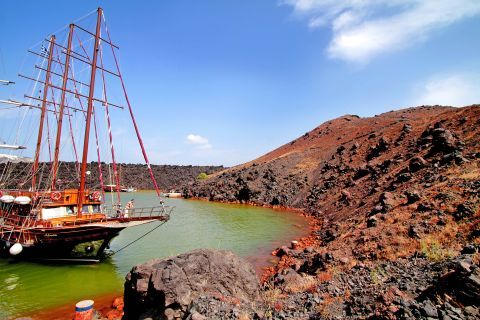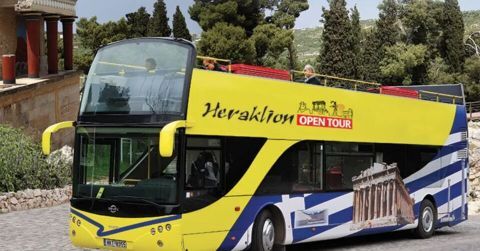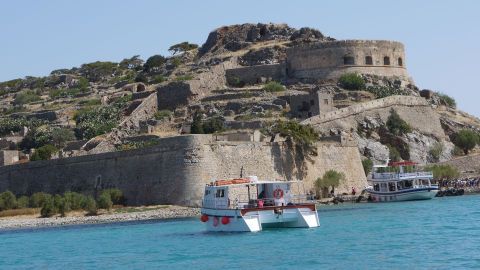Heraklion Town
• General info • Hotels • Things to do & See • Tours & Activities • Map • Members Photos (443) • Greeka Photos (23) • Reviews (4)
Hotels in Town
Dom Boutique
$$-$$$Cozy and modern rooms are available by DOM Boutique Hotel in the center of Heraklion, near the Venetian port and other attractions of the town. The hotel's modern atmosphere guarantees a comfortable accommodation experience and various amenities will be at your disposal. A bar and a breakfast lounge ...
Artion City Boutique
$$-$$$Situated in the heart of Heraklion Town, Artion City Boutique Hotel offers an amazing experience of accommodation in an urban setting. The hotel has a modern interior design and it provides rooms and suites with a unique style. Complimentary amenities are available and you will also find a breakfast ...
Metropole
$$-$$$With an excellent location in one of the most beautiful parts of Heraklion Town, Metropole Urban Hotel is situated near the central square and within a short distance from various local places of interest. It offers both economy rooms and luxury suites with a modern style and a warm atmosphere.
Things to See & Do in Town
Sightseeing
Top Activities & Tours in Town
-
Day cruise to Santorini
Book nowfrom € 199.0011 - 13 hoursCombine your holidays in Crete with a day cruise to the fantastic island of Santorini, the most popular island in Greece. This tour departs from the port of Heraklion early in the morning and includes transfer from your hotel.
-
Hop on Hop off Bus Sightseeing Tour
Book nowfrom € 15.00Category: Hop On Hop Off2 days MapDiscover the history and architecture of Heraklion and admire the views from the top of a double-decker hop-on-hop-off bus with a ticket valid for 48 hours.
-
Day Tour of Spinalonga, Agios Nikolaos, Elounda and Plaka
Book nowfrom € 32.00Category: Day Trips, Island10 hours MapDiscover Crete during a day trip in an air-conditioned coach. Visit Agios Nikolaos and the Elounda Lagoon. Explore the fishing village of Plaka as well as the island and former leper colony of Spinalonga.
Town Map
Photos by Greeka Members
Photos by Greeka Team
Brief History
What is today Heraklion Town was once one of the ports supplying the legendary city of Knossos, however the location itself was for a long time not considered of any importance.
Heraklion’s fate changed in 824 CE, when the Saracens took over Crete, founded an independent Emirate, and chose this site to build their capital. This was named Handaq, Arabic for “trench”, which was eventually Hellenised as Chandax. The Emirs of Crete allowed Chandax to be used as a base for piracy against Byzantine merchant vessels in the Aegean Sea, which eventually forced the Empire’s hand, prompting Nikephoros II to retake the island after a long siege on its capital.
Following the Fourth Crusade, the island was fought over between the maritime republics of Genoa and Venice. The Venetians eventually won out, establishing the Kingdom of Candia, as they called Chandax. As it remained the capital of the island, it was often targeted by rebellious activity, as well as pirate raids and eventually Ottoman aggression. The Venetians built a network of fortifications around the city, some of which still stand today, including Koules Fortress, as do some administrative buildings, for example, the Loggia, and remnants of the old Venetian infrastructure, such as the Lions Fountain.
The Venetian fortifications were so impressive, that when the time came for the Ottomans to take control of Crete, it required a 21-year long siege of Candia, the second-longest siege in history.
Under Ottoman control, Crete’s rebellious activity strengthened, and much of it was focused on Heraklion. This led the Ottomans to commit multiple massacres of the city’s inhabitants, such as in 1770, 1821, and 1898. The Turks also moved the capital from Candia to Chania around 1850.
In 1898, Crete was awarded autonomy and in 1913 it was integrated into Greece. In 1941, Heraklion was one of the main locations targeted by German paratroopers in the Battle of Crete. Finally, it became the capital of Crete once more around 1970.
Sights
Heraklion is a large city with a long and varied history. This has left it with many monuments of days gone by, while its central role in Crete grants it some incredible museums.Fortifications
Venetian City Walls: The western and northern sections of the old walls are mostly intact, running parallel to Archiepiskopou Makariou Street and Nikolaou Plastira Avenue, although the eastern section has been replaced with parks. These are the fortifications that protected the city during the siege of 1648-1669.
Koules Fortress: A classic example of Venetian military architecture, this fortress (also known as Rocca a Mare) has stood guard over the harbor for centuries. Today it functions as a museum with an open-air event court.
Heraklion’s Venetian past is also preserved at the old armory, the arsenali or shipyards, and the Loggia, which today houses some of the local municipality’s executive branches.
Churches
Like most of Greece, Heraklion is tightly packed with churches, some of the most notable being:
Agios Titos: Standing at 25is Avgoustou Street, this church has its roots in the 10th century AD, and has functioned both as an Orthodox and a Catholic temple, as well as a mosque. The current building was constructed in 1869 following an earthquake during its period as an Islamic place of worship and thus has a rather unusual architectural style. It is consecrated to Saint Titus, who created the Church of Crete.
Agios Minas: The largest temple in Crete, and one of the largest in Crete, this Cathedral took 33 years to complete construction during the 19th century. Today it stands as the seat of the Archbishop of Crete and is dedicated to Saint Menas, the patron saint of Heraklion.
Also, Heraklion features Saint John, the oldest Armenian Rite church in Europe, Saint Peter, built by the Venetians in the 13th century, and Saint Mark’s Basilica, which today functions as a municipal art gallery.
Venetian Fountains
The city of Heraklion is known for its unusual amount of old fountains, built during the 400-year duration of the Venetian Kingdom of Candia:
Morosini Lions Fountain: Named after Francesco Morosini, then in charge of Crete, as well as the four lions from whose mouths the water flows, this is perhaps one of the most well-known fountains in all of Greece.
Bembo Fountain: The oldest of Candia’s fountains, it was built in 1552, under orders from Captain Gianmatteo Bembo. Located at Kornarou Square, it is ornately decorated with coats of arms, while at the center stands a carved figure in the style of a Roman statue. In 1776, Hadji Ibrahim Aga built a sebil (a kiosk where water was dispensed to civilians for free) right next to the fountain, to the maintenance of which he devoted his entire wealth.
Other fountains were built by the Venetians, as well as the Ottomans, with about 10 still standing. As Heraklion’s water needs are today covered by modern infrastructure, most of these are now dry, yet the Lions Fountain still functions as Heraklion’s decorative centerpiece.
Minoan Palace at Knossos
The most famous archaeological site in Crete, and one of the most important in all of Greece, the enormous palace complex of Knossos was excavated by Arthur Evans in the late 19th century, uncovering the political and economic center of the Minoan civilization, the oldest politically organized society in Europe.
The complex, sprawling building is theorized to be the inspiration for the myth of the Labyrinth and is very well maintained, with many murals and painted columns retaining the coloration.
The palace is also considered a marvel of Bronze Age engineering, with running water and a separate wastewater drainage pipe network.
Museums
Archaeological Museum of Heraklion: Crete has a long history, stretching back thousands of years, and like any part of Greece, it is filled with archaeological sites and finds. From the Minoan civilization to the many warring city-states of the Archaic and Classical periods, from the Egyptian-Ptolemaic influences to the Greco-Roman years that followed, ancient Crete has had a variety of cultures leave their traces on the island, with those traces safely preserved here.
Historical Museum of Crete: Crete has maintained its historical variety even after the Ancient Period came to pass, with Orthodox, Catholic, and Muslim rulers and many layers of cultural conflict, shaping a unique history and identity.
Natural History Museum: Crete is an island that has been isolated from the mainland for millions of years, and in conjunction with its location at the southern edge of the Aegean Sea, it hosts a unique combination of climatic zones and is home to a number of endemic species of flora and fauna. This museum is dedicated to putting Crete’s natural diversity on display, alongside the natural history of the Earth in general, including a life-size reconstruction of a Deinotherium, one of the largest land mammals to ever live. Also featured in this museum is an earthquake simulator, which offers visitors shakes of up to 7.6 on the Richter scale.
Heraklion also plays host to a plethora of other museums, including Thirathen, a museum of traditional musical instruments, the Museum of Visual Arts, and the Kotsanas Museum of Ancient Greek Technology.
Other sights
The Tomb of Nikos Kazantzakis: One of the greatest Greek writers, who authored such works as “Zorba the Greek”, “The Last Temptation of Christ”, “Captain Michalis”, and “Christ Recrucified”, Nikos Kazantzakis was born in Heraklion. The prolific author, who was nominated 9 times for a Nobel Prize in Literature, is laid to rest at the Martinengo Bastion of the Venetian Walls, with an epitaph bearing his famous phrase: “I hope for nothing. I fear nothing. I am free.”
Beaches
Due to its dense urban development, much of the coast of Heraklion itself has been dedicated to the harbor, with beachgoers seeking locations further away from town. Amoudara Beach, however, is a 6-kilometer-long beach directly to the west of Heraklion, which offers more than enough space for both local and visiting swimmers.
For those willing to travel a bit further, Crete’s northern coast is full of beautiful beaches, from Lygaria in Heraklion’s northwest to Malia in its east.
Restaurants and Nightlife
Restaurants
Restaurants are available throughout Heraklion, but they are centered in the Old Town, within the Venetian Walls, as it is the heart of Heraklion’s economic and social life. Although Greek, and more specifically Cretan cuisine, is naturally prevalent in the area, many foreign cuisines are also represented, owing to Heraklion’s position as Greece’s 4th largest city. Heraklion is by no means one of Greece’s more expensive destinations, and prices are generally on the modest side.
If one seeks out traditional tavernas, they will often notice the word ouzeri tagged onto the name. This indicates a vital part of Crete’s traditional restaurants, as the island has a deep tradition of spirits, such as ouzo, raki, tsikoudia, and tsipouro, which are almost always paired with a good meal.
Cafes and Nightlife
Heraklion is a lively city, with its youthful demographics, bolstered by the universities, keeping cafes and bars in high demand. Cafeterias can be found in any part of the city, from the Old Town to the Harbour and from the suburbs to the beachfront of Ammoudaria.
Bars and nightclubs, on the other hand, are located almost exclusively in the Old Town and along Amoudara, offering classic cocktails, as well as many with a Cretan twist, incorporating the island’s famous spirits.
Hotels
Heraklion’s hotels are mostly located in and around the Old Town, as well as a number of beachside resorts on the coast of Amoudara. Standard hotels are by far the most common type of accommodation available, with prices starting from below €40 and reaching well into the triple-digits per night, depending on the location and the time of year.
Ways to move around
Heraklion’s Old Town can be hard to drive in, as it is made up of narrow roads, whose layout is rather traditional instead of orderly. Especially during the summer months, when visitors flock to the city, this area faces notable traffic congestion. However, most locations are within walking distance from each other here, and one can walk around the perimeter of the Old Town in an hour. A number of parking lots can be found throughout this part of the city, usually charging an hourly fee.
It is generally easier to drive around in the suburbs, where congestion isn’t as high and the roads are laid out more intuitively. A notable feature of Heraklion is its bus network, with more than 20 lines connecting the harbor and the airport with the city’s suburbs, as well as the suburbs with each other. Line 2 also connects the harbor with the palace at Knossos.
Reviews
-
olli.lampinen 14 Sep 2012Interesting place with much historyI visited the Minoan Palace Of Knossos with my wife in April 2012. We went by bus from Rethymno to Knossos.The Minoan Palace was very large over 20,000 square meters. The archaeological site of Knossos is 5 km southeast of Heraklion, in the valley of the river Kairatos. We had a local guide who was very familiar with the history of the Palace. The guide gave us a fantastic presentation of the Palace.
If you go to Crete you must visit the Palace. It is the most important monument at Crete. It was intresting to see how advanced the Minoan civilication was at these times 4000 years ago. They even had a water system. It was fine to see the ruins and the very detailed wall fresco paintings. Sir Arthur Evans made a hard work when he was leader of the excavations. After his death in 1941, responsibility for the excavations was assumed to present day by the British School Of Archaeology. Some parts of the Palace has been built up in recent years, using concrete, was not so good. Our visit there was very impressive. If you like history, I suggest that you visit The Palace In Knossos.
-
ny145 23 May 2010Interesting monuments but busy centreI found the town of Heraklion a bit crowded, but not surprisingly, for this is the main city in Crete. The city is built on the side of a hill overlooking the port and with my fully loaded backpack, the climb to the center of town took quite an effort. Our hotel was in the centre of the island. We stayed in the town for one night and next day took the bus to Chania.
If you are looking for a quiet and tranquil getaway, Heraklion is definitely not the choice. Buses, cars, trucks, blaring horns, busy streets bustling with shops, cafes and restaurants, is pretty much what the city is about. If you happen to take a trip to the central market in the heart of the city, you will be in for a few surprises.
I wandered through the small alleys close to the pedestrian area of the square and came across little shops selling interesting things. Thankfully, the back streets are closed to traffic because they belong to the Old Town. One of the most striking features of Heraklion is its huge harbor crowded with ferries and cruise ships. There is a huge Venetian fortress in the harbor that protected the town from invaders.
The most interesting trip was the Minoan palace of Knossos. I was surprised that such an ancient site is so much well preserved today and in such a good state. This town was very rich once but the tsunami waves of the volcanic eruption of Santorini destroyed it, that is why the archaeologists found it almost intact covered by volcanic ashes.
-
34gyt 14 Mar 2009Busy with traffic jamThe town of Heraklion is not very beautiful, compared to the other big towns in Crete, such as Chania and Agios Nikolaos. The best thing about the town is the port and the strong Fortress on its side. It will take you more than an hour to walk all over the fortress, take pictures and see the view. Such castles are found in other towns of Crete, too, and in many Greek places. It is impressive that they have survived so many centuries, isn't it? Apart from the fortress and the archaeological museum, Heraklion town is a busy centre with a lot of traffic jam and full cafeterias in all spots. I remember we were walking for about half an hour up and down the waterfront to find a table to seat and drink a proper coffee.
-
despstil4 02 Aug 2008Like all the modern townsThe actual town of Heraklion is busier than the other towns of Crete. Too many stores and too much traffic was the dominant sight all around. The cars would make much noise and didn't let you enjoy a coffee at the waterfront. Personally, I prefered the quiet villages of south Crete more than its busy towns. I think a good reason to go to Heraklion is to see the Castle and eat cheap and fresh seafood at the beach. Otherwise, it is like all the normal modern towns.












